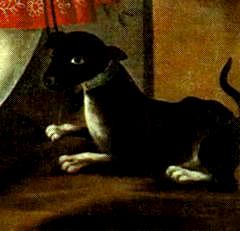
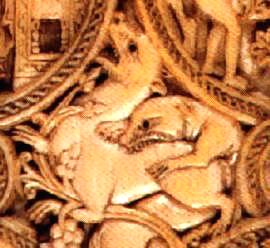



 Moreover, the comparison shows that Kolendas' dog above has three toes of equal length, like the beasts from the psalter-cover, and the monster in the mouth of hell, while in reality dogs have four, with the middle two longer than the outer two. The dog belonging to the anonymous Boy with Toys has the curved fang of the iconic creature, but anatomically correct feet. Click on the paws at the left and right to see these images again. Oddest of all in this respect are the pugs on the snuff-box lid: though they are a fashionable contemporary breed, part of the modern world that intruded on 18th-century Russia and quite unlike the older traditional breeds, they have archaïc three-toed feet like Kolendas' dog. To see them again, click on their feet at the foot of the page.
Moreover, the comparison shows that Kolendas' dog above has three toes of equal length, like the beasts from the psalter-cover, and the monster in the mouth of hell, while in reality dogs have four, with the middle two longer than the outer two. The dog belonging to the anonymous Boy with Toys has the curved fang of the iconic creature, but anatomically correct feet. Click on the paws at the left and right to see these images again. Oddest of all in this respect are the pugs on the snuff-box lid: though they are a fashionable contemporary breed, part of the modern world that intruded on 18th-century Russia and quite unlike the older traditional breeds, they have archaïc three-toed feet like Kolendas' dog. To see them again, click on their feet at the foot of the page.An East European term of comparison is provided by the dog in the image below right, a detail from a religious painting of about 1490 by an anonymous Austrian or Hungarian artist, The Miraculous Discovery of the Graves of Saints Felix, Regula and Exuperantius. The anatomical details of the dog are quite accurate, including the ears, the snout, the feet and the tail, which has the curve of a real dog's tail instead of the stylized, anatomically impossible double curve seen in the Portrait of Nicholas Temerin and the Child with a Dog, below center. This feature is part of an extremely old animal stylization in the art of the Greco-Roman world: for example, it can be discerned, along with the familiar tongue, teeth and ears, in the image of a lion on an Athenian clay tripod of the 8th century BC, below left.



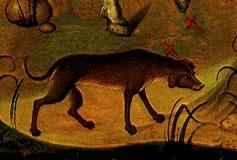
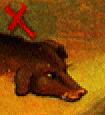 its jaw shows a hint of the stylized fang that characterizes the iconographically hybrid creature at the mouth of hell. Click on its head at the right to see it standing beside the crosses marking the graves in a landscape that includes a deer. This image, though on one level it looks like a hunt scene, is probably another visual relict of the dog that is associated with graves and the mouth of hell. It also brings us back unexpectedly to the realm of landscape,
its jaw shows a hint of the stylized fang that characterizes the iconographically hybrid creature at the mouth of hell. Click on its head at the right to see it standing beside the crosses marking the graves in a landscape that includes a deer. This image, though on one level it looks like a hunt scene, is probably another visual relict of the dog that is associated with graves and the mouth of hell. It also brings us back unexpectedly to the realm of landscape,  as both the dog and the deer have their place in an archaïc, emblematic landscape that was widespread in late Classical and early Byzantine art, and is connected with death or entrance to the underworld. Elements of this landscape are sometimes incongruously woven into Byzantine and later icons. Click on the thumbnail at the left to see an early 16th-century example from the Balkans, the lower part of an icon of the Nativity in which the "canonical" animals (the asses and cattle of the manger, the shepherds' sheep and sometimes the horses of the Magi) are augmented by the dog, deer and hare of the older tradition.
as both the dog and the deer have their place in an archaïc, emblematic landscape that was widespread in late Classical and early Byzantine art, and is connected with death or entrance to the underworld. Elements of this landscape are sometimes incongruously woven into Byzantine and later icons. Click on the thumbnail at the left to see an early 16th-century example from the Balkans, the lower part of an icon of the Nativity in which the "canonical" animals (the asses and cattle of the manger, the shepherds' sheep and sometimes the horses of the Magi) are augmented by the dog, deer and hare of the older tradition.
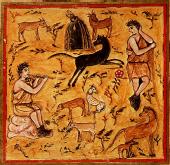 There is an important lesson to be learned here about the interpretation of older landscapes. In European painting since the late Renaissance, animals in a landscape generally have a decorative or a genre function. However, in earlier times, or in countries in which earlier traditions lingered late, we may be dealing with images that hark back to a small repertoire of ancient conventional landscapes whose elements, including the people and animals to be found in them, are mythic or symbolic. The painting on the left, another illustration from the Vergilius Romanus, is an example of the puzzling animal iconography often found in late classical and early Byzantine landscapes - click on it for a detailed view. Images of this kind may preserve some of their pictorial attributes for centuries, even in transmission across national boundaries, and landscapes that contain them may similarly retain some of their original iconic function.
There is an important lesson to be learned here about the interpretation of older landscapes. In European painting since the late Renaissance, animals in a landscape generally have a decorative or a genre function. However, in earlier times, or in countries in which earlier traditions lingered late, we may be dealing with images that hark back to a small repertoire of ancient conventional landscapes whose elements, including the people and animals to be found in them, are mythic or symbolic. The painting on the left, another illustration from the Vergilius Romanus, is an example of the puzzling animal iconography often found in late classical and early Byzantine landscapes - click on it for a detailed view. Images of this kind may preserve some of their pictorial attributes for centuries, even in transmission across national boundaries, and landscapes that contain them may similarly retain some of their original iconic function.




